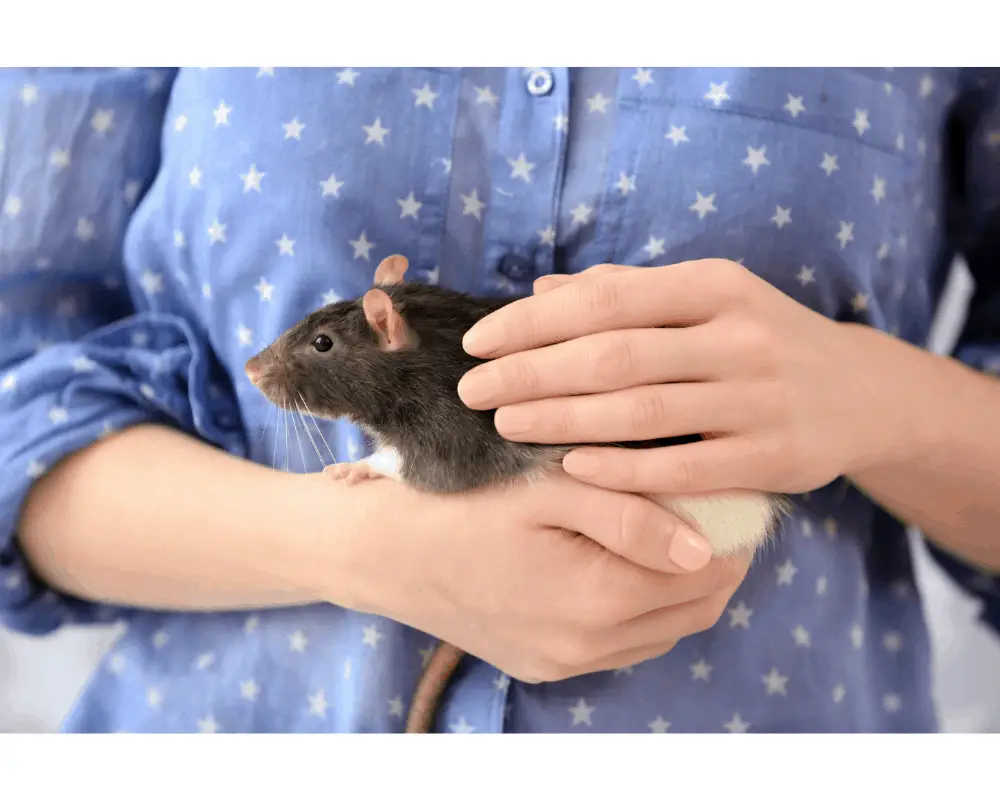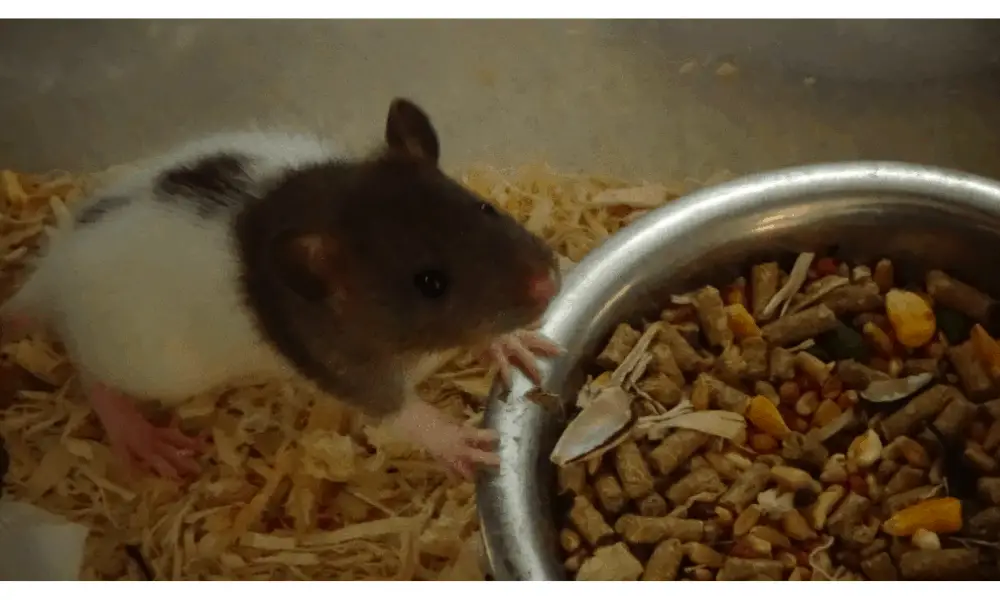
Rats are intelligent, affectionate, and cheerful playmates and if you’ve ever considered getting a rat as an animal companion, you might have wondered how long they can live. So in this article, we will explore the average life expectancy of a pet rat as well as provide you with a complete guide on how you can keep them happy and healthy in order to extend their lifespan as much as possible.
So how long do pet rats live? The average lifespan of a pet rat range between 18 and 36 months [1], whilst the oldest pet rat ever recorded reached a world record age of 7 years and 4 months, according to the Guinness Book of World Records (1995 edition).
How long your pet rat will live may depend on certain predisposing genetic factors, but the biggest influence on their lifespan will actually be the care that they will receive from you, their owner. So, let’s look at a couple of things that you need to implement early on in order to help them live as long as possible.
Pet Rat vs Wild Rat Lifespan
In order to understand how long we can expect our pet rats to live, we need to delve into their history and see where these unusual critters came from. This may be difficult to believe, but people used to frown upon those cute faces and inquisitive noses, and it wasn’t until the early 1800’s that rats began to make their transition from pest to pet.
Rats were known to carry many deadly human diseases, and pest control, therefore, became a very popular and important career path within Europe and the United Kingdom. Exterminators stumbled upon many different kinds of rats, and despite their best efforts to eliminate these colonies, some of them actually began to keep these unusual rodents and started to breed with them. These rats were then sold as pets and hence the birth of the domesticated rat that we know today.
In the early stages of domestication, the lifespan of a pet rat was around 6 to 11 months, which is similar to what we can expect from a wild rat today. As pet owners started to learn more about proper rat care, feeding requirements and veterinary treatments, the life expectancy of pet rats began to increase to more than 2 years in captivity.
Rats in the wild obviously face many more dangers than those kept as pets, as they are a very common prey animal for many predators, are severely susceptible to food shortages, and easily succumb to diseases due to lack of access to veterinary care. It is therefore not surprising that the lifespan of a wild rat is much shorter than that of a pet rat.
Which Factors Affect The Lifespan Of A Pet Rat?
The most important factors affecting a pet rat’s lifespan include genetics, nutrition, and health.
Genetics
Inbreeding can affect both a rat’s health and concurrent lifespan. Inexperienced breeders may pass on undesirable traits, such as a hereditary health condition, that can claim a rat’s life early on.
Nutrition
Proper nutrition is key to ensure that your pet rat will have a long and healthy lifespan. Make sure that they are only eating food that is safe and specifically designed for rats and is aware of which human foods are safe to give as treats and which ones are toxic.
Health
Rats are prone to various upper respiratory infections, tumors, and skin parasites and because they are prey animals, they tend to hide signs of illness in the early stages. Early detection of diseases is extremely important for treatment options and life expectancy, so don’t unnecessarily wait too long before taking it to a veterinary professional when you start to notice that something is off.
Signs of disease to watch out for, include:
- Weight loss
- Reduced mobility in their joints
- Sneezing
- Discharge from the eyes
- Lumps under the skin
- Hair loss
- Overgrown teeth

How To Increase The Lifespan Of Your Pet Rat
In order to increase the lifespan of your pet rat as much as possible, you need to start applying the correct methods even before getting a rat, straight through its entire lifespan.
Choosing A Healthy Pet Rat
The rat’s life cycle is generally divided into 4 phases: Newborn, 4 Weeks, 1 Year, and Over 1 Year.
Newborn rats are very small, blind, and very dependent on their mothers. They grow quickly though and begin to crawl at around 5 days and open their eyes at around 2 weeks of age.
At around 4 weeks a young rat will start to become independent of its mother and will be fully alert and able to feed itself.
Only around 6 to 8 weeks of age will it be safe to bring a baby rat home. So make sure that you confirm the rat’s age with a trusted, reputable breeder, as taking a rat that is too young away from its mother will result in stunted growth and may result in it not even reaching adulthood, thereby decreasing its life expectancy dramatically.
Look for an active, curious rat with a shiny coat and bright eyes. It should not be sneezing, or have a runny nose or eyes and its droppings should be dark and firm.
Feeding Your Pet Rat Correctly
The most important thing to remember about feeding your pet rat is to not overfeed it. Rats that are fed too much unhealthy food can quickly become obese, and studies have shown that reducing the amount of food given to rats by just a small amount can increase a pet rat’s lifespan significantly and therefore improve its overall health [2].
With that said, you should also not starve your pet rat, as underfeeding and lack of protein during pregnancy and the first 8 weeks of life have been attributed to an increased risk of early kidney failure and a shorter lifespan [3].
Healthy food for your pet rat include commercially formulated rat pellets as well as fresh vegetables such as carrots, broccoli, berries, kiwis, nectarine, beetroot, and peas. You may also feed your rat fresh fruit as an occasional treat, but do not overdo this and especially avoid feeding diets high in sugar and fat.
Maintaining a good lean weight for your rat is probably the best thing that you can do to maintain its health and lifespan, and the most effective way to achieve this is to implement a combination of:
- Low-fat diet
- Scatter feeding
- Intermittent fasting
- Activities that will promote exercise
A great way to be able to detect diseases early on, is to weigh your pet every week in order to detect any deviations from their normal weight.
Optimizing The Environment For Your Pet Rat
Rats need to be active from a young age onwards in order to be kept healthy. You need to try and create an environment that allows them to engage in natural behaviors such as climbing, balancing, foraging, and digging as this will keep them fit and will therefore prevent obesity.
Two ways to achieve this are by providing a spinning wheel and investing in a tall barred cage. Wheel running has been shown to extend the average lifespan of rats [4], but make sure that the wheel is big enough (around 16-inch in diameter) for the rat to run around in, in order to avoid unnecessary injuries such as tail curling or spinal issues. A tall cage will encourage climbing and thus help to maintain their ideal weight.
To prevent respiratory infections and mite infestations, keep your rat’s cage clean and well-ventilated. Make enough provision of things to gnaw on, such as wood blocks in order to prevent your rat’s teeth from overgrowing.
Rats are very sensitive to temperature fluctuations. Keep their cages out of direct sunlight and away from extreme heat or cold. The temperature inside their enclosure should generally range between 65 and 70 degrees Fahrenheit, or degrees Celsius.
Providing Veterinary Access To Your Pet Rat
As the interest in keeping rats as pets begin to rise, the demand for veterinary treatment starts to encourage more vets to expand their knowledge and expertise towards learning how to medically treat rat diseases. This has a major impact on expanding the life of your pet rat as they can now be treated and potentially cured of diseases that in the past could have resulted in their death.
Ideally, you would want to have access to a veterinarian that is trained in treating rats, but if this is not possible, then make sure you rely on reputable resources on the internet that can provide you with the best tips and advice on taking care of your pet rat.
The articles here on www.petvettips.com are written and reviewed solely by veterinarians themselves, so if there is something that you need more information on, please browse our list of blog posts to see if we have the answers that you are looking for.
Minimizing Your Pet Rat’s Exposure To Dangers
There are a number of toxins in the environment that have the potential to shorten a pet rat’s life. These can include ammonia, cigarette smoke, and phenols.
Ammonia
Ammonia is a by-product of the breakdown of urine and can cause inflammation of the airways which can lead to severe respiratory problems. You can avoid ammonia build-up by changing the cage litter and bedding regularly before any ammonia smell starts to develop.
Smoke
Rats should ideally be kept in a smoke-free environment as exposure to smoke can also cause respiratory problems and may even lead to some tumors. If you are a smoker, make sure you smoke in a different room and keep the door shut.
Phenols
Phenols develop as a result of untreated pine and cedar and can cause raised liver enzymes and some tumors. Phenols can easily be avoided as you can just buy paper, card, hemp, aspen, or kiln-dried pine products for use in your rat’s cage.
Remove Severe Stressors From Your Pet Rat’s Life
Rats can easily stress in response to fearful, uncertain, and challenging circumstances. These may include:
- Moving to a different home
- Changing the social structure in a group
- Social stress resulting from dominance, bullying and bickering amongst rats
- Illness
- Overcrowding
- Death of a cage mate or loss of a significant human
Never underestimate the impact of an unsettled group of rats, as some research has shown that social stress can create a much stronger stress response in rats than negative experimental techniques such as immobilization and electric shocks [5].
Rats are also social creatures that need to be housed in social groups. Research has suggested that both positive social groupings and positive human handling can cause changes in the rat’s cells that reduce the rate of aging.
Another easy way to potentially reduce the stress levels in rats, is by playing high-pitched classical music in the background, according to one study [6].
Conclusion
Despite the below-average lifespan of pet rats, there are many things that we can implement to buy as much time as possible for us and these furry companions. We hope that this article served as a guide to improve your pet rat’s life expectancy significantly and that you are able to implement these easy tips and tricks successfully.

